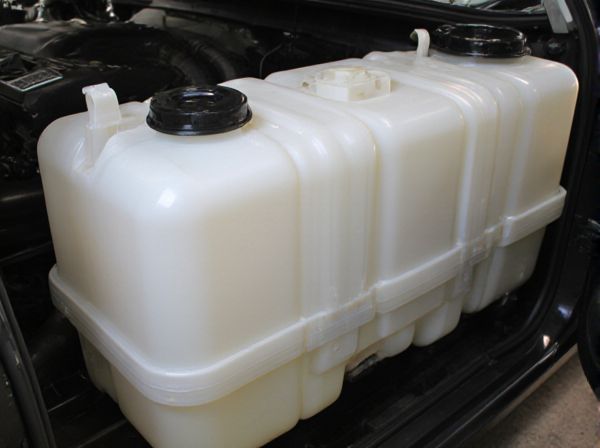
Photo illustration: Ventilated Tank vs Sealed Tank
A ventilated tank allows air circulation to prevent pressure buildup and condensation, ideal for applications where moisture control is critical. Sealed tanks, in contrast, are airtight to maintain internal conditions and prevent contamination, making them suitable for storing volatile or sensitive substances. Your choice depends on whether you prioritize pressure regulation or contamination prevention in the tank's operating environment.
Table of Comparison
| Feature | Ventilated Fuel Tank | Sealed Fuel Tank |
|---|---|---|
| Airflow | Allows air exchange to prevent vacuum build-up | Fully sealed to prevent air and vapor escape |
| Emissions | Higher evaporative emissions due to ventilation | Lower emissions with controlled vapor recovery system |
| Fuel Evaporation | Increased evaporation risk | Minimized evaporation loss |
| Pressure Regulation | Natural pressure equalization via vent | Uses pressure sensors and valves for regulation |
| Complexity | Simple design, low cost | More complex, higher manufacturing cost |
| Maintenance | Requires regular vent inspection | Less frequent maintenance due to sealed design |
| Environmental Impact | Less environmental friendly | Eco-friendly with reduced vapor release |
Introduction to Ventilated and Sealed Tanks
Ventilated tanks feature an opening that allows air exchange, preventing pressure build-up and reducing the risk of structural damage due to vapor pressure changes. Sealed tanks are airtight containers designed to prevent the ingress of air and contaminants, maintaining internal pressure and protecting sensitive contents from external environmental factors. Understanding the differences between ventilated and sealed tanks is crucial for selecting the appropriate system for fuel storage, chemical containment, and industrial applications where safety and preservation are priorities.
Key Differences Between Ventilated and Sealed Tanks
Ventilated tanks are designed with openings that allow air to flow in and out, preventing vacuum buildup and enabling pressure equalization, which is essential for fuel expansion and contraction. Sealed tanks, in contrast, are airtight to prevent vapors from escaping, reducing emissions and enhancing environmental safety but requiring specialized venting systems to manage pressure changes. The key difference lies in how each tank handles vapor and pressure: ventilated tanks rely on passive air exchange, while sealed tanks use controlled venting mechanisms to maintain integrity and comply with environmental regulations.
How Ventilated Tanks Work
Ventilated tanks function by allowing air to circulate between the interior of the tank and the external environment, preventing vacuum formation and maintaining pressure equilibrium. They typically feature a vent pipe or opening that promotes oxygen exchange while preventing excessive pressure buildup, which reduces structural stress and potential leaks. This design is essential for applications involving fluids susceptible to vapor lock or evaporation, ensuring stable fluid levels and system efficiency.
How Sealed Tanks Operate
Sealed tanks operate by maintaining a closed environment that prevents external air and contaminants from entering, ensuring the stored liquid remains uncontaminated and stable. These tanks use pressure relief valves or vacuum breakers to manage internal pressure changes caused by temperature fluctuations or liquid displacement. Unlike ventilated tanks, sealed tanks minimize evaporation losses and reduce the risk of oxidation, making them ideal for sensitive liquids.
Advantages of Ventilated Tanks
Ventilated tanks offer superior pressure regulation by allowing air to flow freely, reducing the risk of vacuum formation and structural damage. They prevent the buildup of harmful gases and maintain consistent oxygen levels, enhancing safety and prolonging the tank's lifespan. This ventilation also supports easier maintenance and inspection by minimizing condensation and corrosion inside the tank.
Benefits of Sealed Tanks
Sealed tanks prevent contamination and evaporation by maintaining a controlled internal environment, which enhances fuel quality and reduces maintenance costs. They minimize the risk of environmental pollution by containing vapors, meeting stringent regulatory standards. The improved safety and longevity of stored liquids make sealed tanks ideal for sensitive applications in industries like pharmaceuticals and fuel storage.
Common Applications for Ventilated Tanks
Ventilated tanks are commonly used in wastewater treatment, agricultural storage, and chemical processing industries due to their ability to release gases and prevent pressure buildup. These tanks are ideal for storing organic liquids and materials that produce volatile gases, ensuring safe venting and reducing the risk of explosion or tank deformation. Applications include septic tanks, slurry storage, and biogas digesters where gas exchange is essential for maintaining system stability.
Typical Uses of Sealed Tanks
Sealed tanks are commonly used in applications requiring containment of hazardous or volatile fluids to prevent leaks and contamination. Industries such as chemical processing, pharmaceuticals, and food and beverage manufacture rely on sealed tanks for secure storage and maintaining product integrity. Their ability to maintain a controlled environment makes them ideal for sensitive substances susceptible to oxidation or evaporation.
Choosing Between Ventilated and Sealed Tanks
Choosing between ventilated and sealed tanks depends on the specific application and fluid characteristics. Ventilated tanks allow air exchange to prevent vacuum or pressure buildup, making them ideal for non-hazardous fluids that require pressure equalization. Sealed tanks provide airtight containment to protect volatile or hazardous liquids from contamination and evaporation, ensuring safety and environmental compliance.
Maintenance and Longevity Considerations
Ventilated tanks require regular inspection and cleaning to prevent moisture buildup and corrosion, which can shorten their lifespan. Sealed tanks offer enhanced protection against contaminants, reducing maintenance frequency and extending longevity by maintaining a stable internal environment. Choosing between the two depends on the application's exposure to external elements and the desired maintenance schedule.
 caratoz.com
caratoz.com